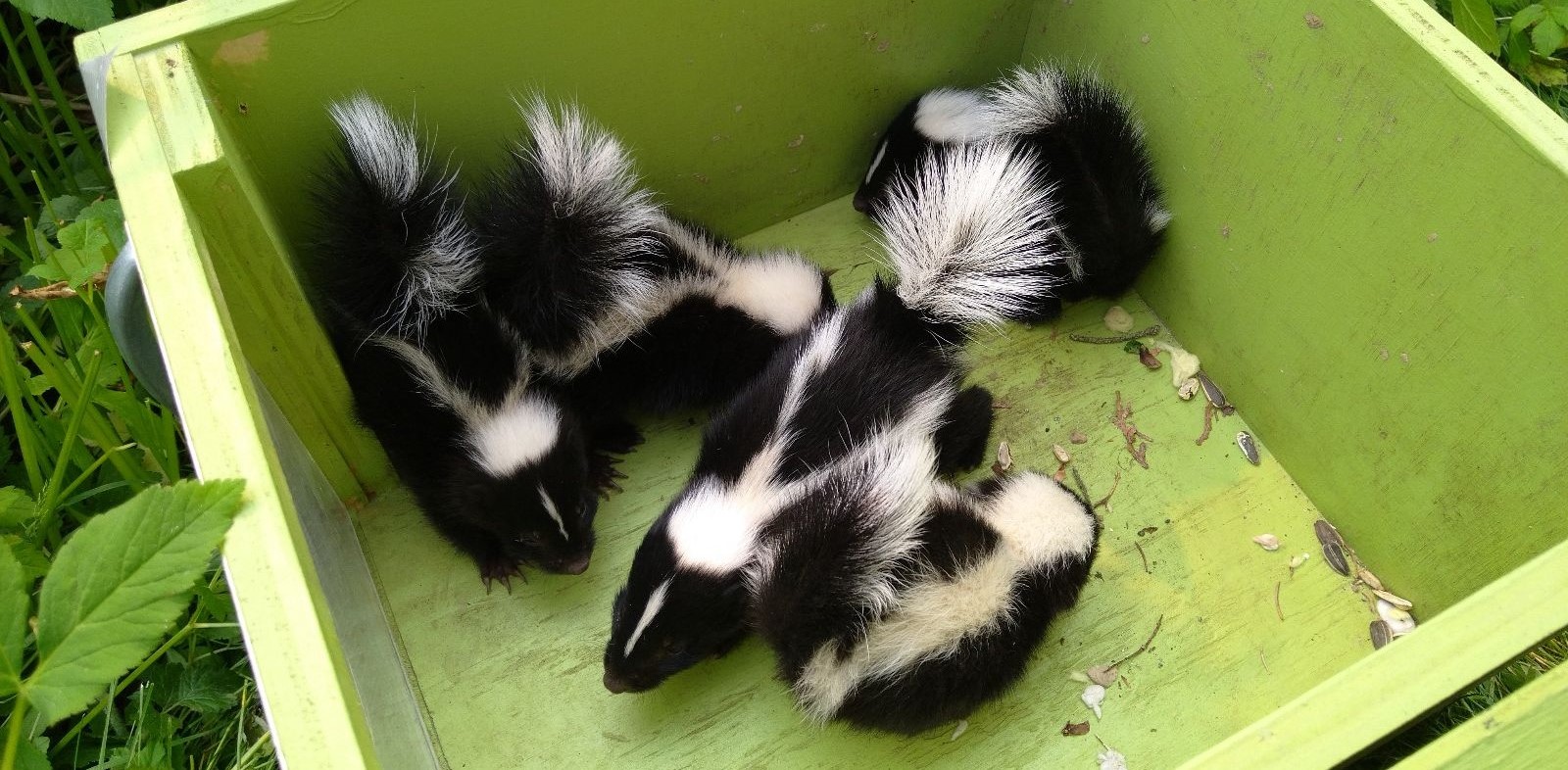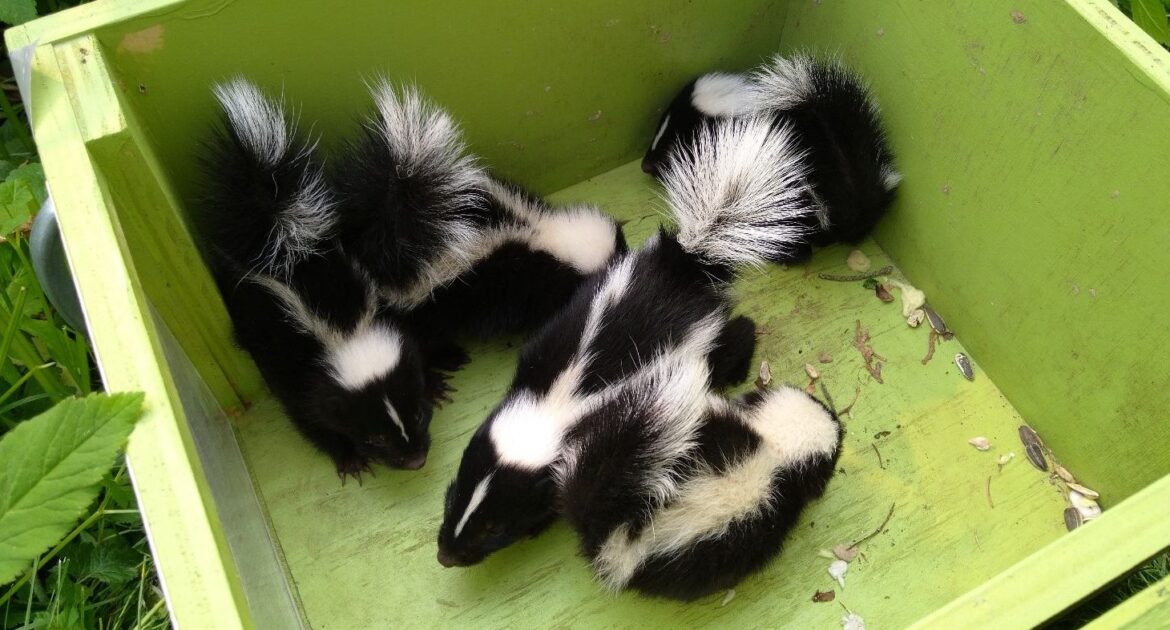If you’ve smelled something unpleasant wafting around your yard or noticed unusual activity near your property, you might have a skunk under your porch. Skunks are known for their digging abilities and their distinct, lingering odour. Identifying signs of skunk infestation early is key to handling them humanely and ensuring your property remains safe and clean.
Below, we’ll explore the most common indicators of a skunk presence, giving you the tools to confirm whether these nocturnal diggers have made their home under your porch. We will also discuss how our team at Skedaddle offers humane skunk removal in Durham to help keep your home and family safe.
Skunk Under Porch
One of the clearest signs of a skunk under your porch is spotting the skunk itself. These animals are nocturnal, with most of their activity occurring during the evening hours. They tend to wander out of their dens to search for food, which typically consists of grubs, insects, fruits, and small animals. If you notice a small black-and-white animal with a waddling gait heading toward or away from your property, chances are you’re dealing with a skunk.
However, direct sightings aren’t your only clues. Other evident signs indicating a skunk presence under your porch include:
- Digging: Skunks are skilled diggers, often creating entry points under porches, decks, or sheds. Look for freshly dug soil or sizeable holes near your property’s base.
- Odour: The most recognizable indicator is the unpleasant and pungent smell associated with skunks. Even a mild whiff may suggest their presence, especially if the scent lingers.
- Nocturnal Noises: Skunks are generally active at night. Scratching, rustling, or digging noises emanating from beneath your porch may indicate activity.
- Tracks and Droppings: Skunk tracks feature five toes with visible claw marks. Additionally, their droppings are typically tubular and include insect remains.
If you observe any of these signs, it’s safe to assume there may be a skunk living under your porch. Early detection can help minimize potential issues, such as unpleasant odours or structural damage.
Signs Of Skunk Infestation
Identifying a skunk infestation involves looking for subtle and not-so-subtle clues around your property. Skunks prefer safe and sheltered spaces where they can burrow and create dens, making porches, decks, and sheds ideal locations. Here are the telltale signs of a skunk infestation:
- Visible Burrows
Skunks dig burrows to create dens, leaving visible mounds of dirt near entry points. Their dens are typically around 8 inches in diameter and often located under structures.
- Damage to Lawns or Gardens
Skunks frequently dig small, cone-shaped holes in search of grubs and insects, leaving evidence of their nighttime foraging in your yard or garden.
- Ammonia or Rotten Odour
Even if the skunk hasn’t sprayed, their den may release a faint musky odour. If they’ve recently sprayed, the smell can be significantly stronger and may linger around your property.
- Footprints and Tail Drag Marks
Skunks leave characteristic footprints with five toes and sharp claws. Additionally, their dragging tails can leave streaks behind on soft surfaces.
- Unexplained Sightings of Small Holes
If you notice finger-sized holes in your garden or lawn, skunks may be foraging for food nearby.
Understanding the signs of skunk infestation enables you to act promptly before the situation escalates. Skunks can be territorial, so addressing the issue sooner reduces the likelihood of further complications.
How To Identify Skunk Presence
Identifying a skunk presence requires more than just noticing an unpleasant odour. These tips can help determine whether you’re dealing with a skunk in or around your property:
- Monitor Movement Patterns
Skunks are creatures of habit. Once they find a location with food and shelter, they tend to stick around. Use a motion-activated camera to spot nightly activity near your porch or yard.
- Inspect for Skunk Fur or Tracks
Skunks often leave behind tufts of hair near burrow entrances or tracks in soft ground. Their tracks are distinctive due to their five toes and outward-pointing claws.
- Check for Dirt and Displacement
Skunks move significant amounts of dirt when creating their burrows. If you find large piles of soil near openings or gaps under your porch or deck, it’s a strong indication of their activity.
- Observe Behaviour of Pets
Dogs and cats may react to the smell of skunks or show curiosity toward areas with activity. Any unusual behaviour from your pets around your porch may suggest a hidden guest.
- Look for Food Scraps or Waste
Skunks can rummage through garbage or feed on leftover food. Check your yard for overturned trash bins or scraps scattered around.
- Conduct a Visual Inspection
Use a flashlight to check under porches, decks, or sheds. Be cautious and maintain a safe distance, as skunks may feel cornered and agitated.
Being proactive in identifying skunk presence ensures humane and timely intervention, minimizing the impact on your property.
Steps To Take If You Suspect A Skunk Presence
- Suspecting a skunk living under your porch can be concerning. Here’s a step-by-step guide to handle the situation responsibly.
- Start by verifying the presence of a skunk. Look for multiple signs in combination, such as odour, tracks, and burrowing activity, to confirm their presence.
- Never attempt to directly engage with a skunk. They may perceive threats and release their spray as a defense mechanism, so it’s best to avoid confrontation.
- Remove attractants like open food containers, garbage, pet food, or easily accessible fruit to make your property less appealing to skunks. Securing your trash and food sources is a key step in prevention.
- Bright light can deter skunks from returning to their den. Use motion-activated lights to illuminate the area and make your porch less inviting.
- If you’re certain that a skunk is present, consult trained wildlife control experts like us at Skedaddle. We specialize in humane removal and prevention techniques to ensure the situation is resolved effectively.
By taking these steps, you can handle the issue responsibly while reducing the likelihood of future skunk visits to your property.
Ways To Prevent Skunk Infestation
Prevention is the best solution when it comes to managing wildlife near your home. Here’s how you can minimize the risk of a skunk infestation:
- Install Barriers
Seal off access points under porches, sheds, and decks using durable screens or mesh buried at least 12 inches into the ground.
- Trim Overgrowth
Skunks prefer sheltered areas with dense vegetation. Keeping grass short and removing brush piles can make your yard less appealing.
- Remove Food Sources
Dispose of trash in sealed bins and make sure compost piles are properly covered. Collect fallen fruits and nuts from your yard regularly.
- Regular Property Inspections
Conduct periodic checks to ensure no new burrows and assess your property for potential wildlife activity.
- Use Natural Deterrents
Place vinegar-soaked rags near potential entry points for a safe, effective deterrent. However, ensure these are placed outside to avoid odours inside your home.
By implementing these strategies, you can prevent skunks from settling on your property and maintain a safe, clean environment.
Make Your Porch Skunk Free Today
Skunks under porches are more than just a nuisance; they can cause significant damage and leave lasting odours on your property. Knowing the signs of their presence helps address the issue early while preventing further complications.
If you suspect a skunk has made its way under your porch, reach out to our experienced wildlife control team at Skedaddle in Durham. With decades of expertise in humane removal and prevention, we’re here to help you secure your property. Contact us today to learn more!




